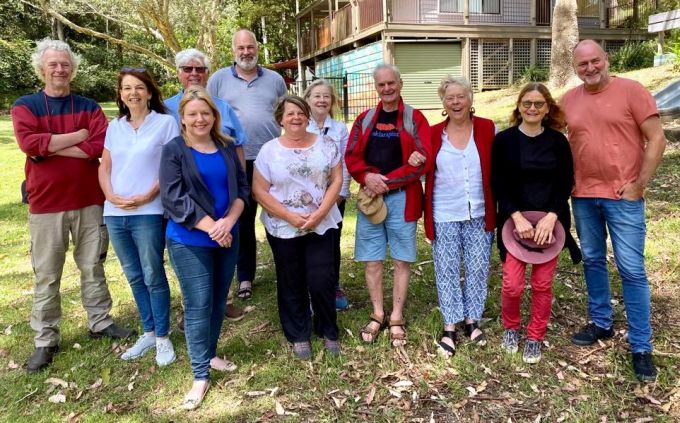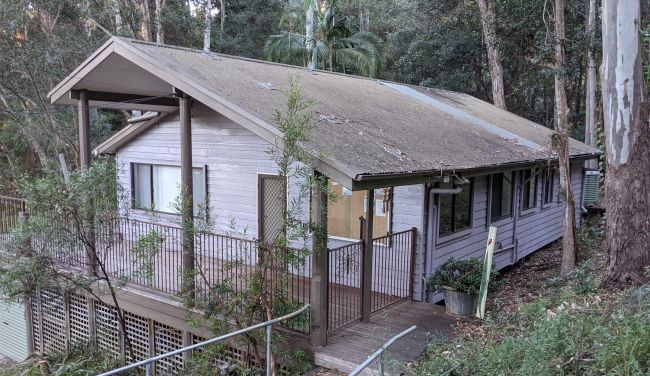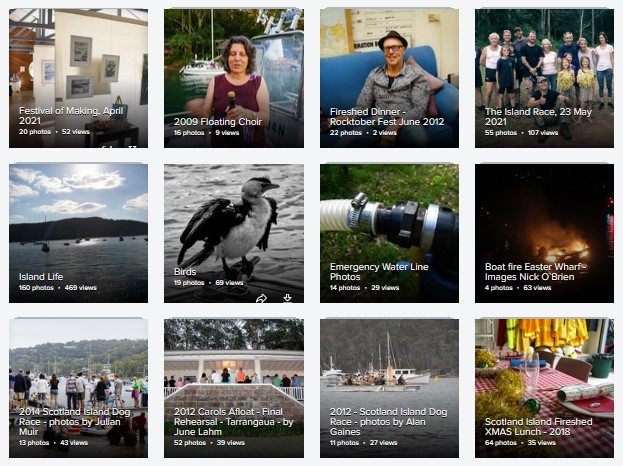| Having trouble reading this newsletter? Visit https://ymlp.com/archive_gesgjgm.php | ||||||||||||||||||||
 |
||||||||||||||||||||
November 19, 2021 |
||||||||||||||||||||
|
Newsletter for the
Offshore Residents of Pittwater, Australia - Volume 22,
Issue 1164
We acknowledge and pay our
respects to the Traditional Custodians of
Pittwater, as well as our indigenous readers
|
||||||||||||||||||||
Contents
The New SIRA Committee
The AGM for the Scotland Island Residents' Association, held on 14 November, saw few changes to the committee. The principal office holders remain much the same, with Colin Haskell staying on as president, Sharon Kinnison as vice-president and Juliet Wills as secretary. The one change is that Tim Turpin steps down as treasurer, although he will remain on the committee. The new treasurer is Sharon Dwyer. Marie Minslow and Brian Rodgers resigned from the committee. Its ordinary members are now: Sue Armstrong, Boyd Attewell, Fabienne d'Hautefeuille, Janette Davis, CB Floyd, Robyn Iredale, Mark Martin, Shane O'Neill, Tim Turpin and Duncan Watts. Congratulations go the new members of the committee, and our thanks to both departing and continuing members.  Grant
Success for SIRA
|
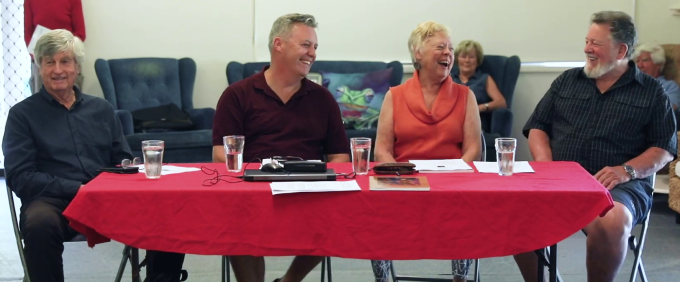 |
| The
forum's panel (left to right): islander
Craig Burton, local historian Paul
Griffiths, chair Robyn Iredale & Neil Evers, chair of the local Aboriginal support group. |
On 6 November, three authorities on local history met with offshore residents to discuss Pittwater’s Indigenous past. The forum, held in Scotland Island’s Recreation Centre, was the first step towards the writing of a play, to be staged on the island next year, focusing on the lives of Catherine Benns and Catherine Bouffier. These two Catherines, remembered in the name of the Recreation Club’s café, both played a part in Pittwater's past. Bouffier was mother of the eponymous Elvina, who gave her name to the bay, while Benns was called ‘Queen of Scotland Island’.
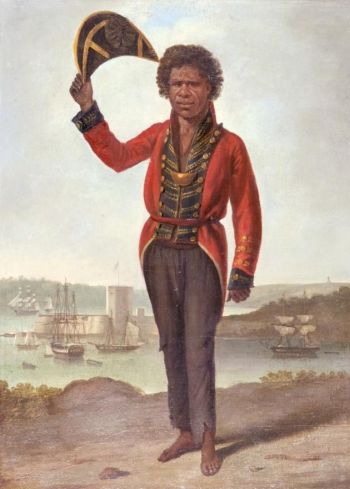 |
|
Bungaree
(1775 - 1830), by Augustus Earle (1826)
|
The panel consisted of three speakers. The first, Neil Evers, is chair of the Aboriginal Support Group, Manly Warringah Pittwater. Like Catherine Benns, Neil is a direct descendant of Bungaree. Neil described how his ancestor accompanied Matthew Flinders on the first known circumnavigation of Australia, which began in 1801. During the voyage Bungaree played a vital diplomatic role, liaising with the Indigenous peoples met along the way.
After his return to Sydney, Bungaree was granted a farm on George’s Head at Mosman. Neil described how, while there, a convict fell in love with Bungaree’s granddaughter. The couple had 10 children, one of whom was James, Neil’s great-grandfather. Another of the children was Catherine Benns, making her the aunt of Neil’s grandfather.
Catherine’s link with Scotland Island came through her husband Joe Benns. Born in Belgium, Benns arrived in Pittwater sometime around 1850 and leased the island from the estate of its purported owner, John Dickson. Later, Benns successfully challenged Dickson’s title to the island and then laid claim to it.
After their marriage in 1874, Catherine and Joe Benns occupied the site of the house built by Andrew Thompson, Scotland Island’s first European owner. This stood close to what is now known as Tennis Court Wharf. Prior to marrying Joe, Catherine had a daughter out of wedlock, named Emily. This girl married George Godbold in 1887, and the Benns and Godbold families lived in the same house on Scotland Island.
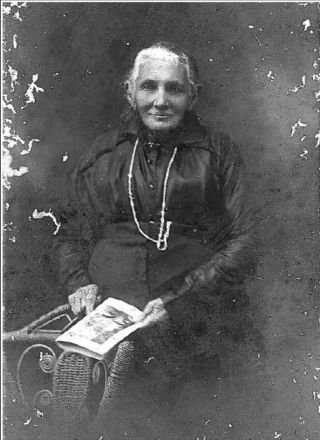 |
|
Catherine
Benns (1838 - 1920)
|
The panel of speakers also included islander Craig Burton, a landscape architect with a long interest in Indigenous history. Craig has studied middens and also the planting by Aboriginal peoples of kurrajong trees, which held particular cultural and practical significance.
Craig told the meeting how he first came across Catherine Benns. Contrary to what is sometimes thought, local Indigenous people did not simply disappear after European incursion. Rather, they remained ‘hidden in plain view’, their Aboriginality not always explicitly acknowledged. But Craig suspected from the beginning that Catherine was Aboriginal: ‘she was described as a “small dark woman”. That’s interesting, I thought’.
Although Catherine is commonly termed a ‘midwife’, Craig suggested that it’s likely she was more broadly involved in traditional ‘women’s business’. She was also said to trade in sea shells, which might also suggest a deeper connection with ongoing Indigenous culture, given the reliance of coastal Aborigines on seafood.
Later Craig’s career led him to a project at George’s Head, which involved him in research into Bungaree. According to Craig, Bungaree’s family wasn’t originally from Broken Bay but came from further north. Bungaree’s people were renowned for their linguistic skills, hence Bungaree’s usefulness to Flinders. Bungaree, finding himself outside his native country, would have been bemused at the British description of him as ‘King’ of Sydney's ‘Blacks’.
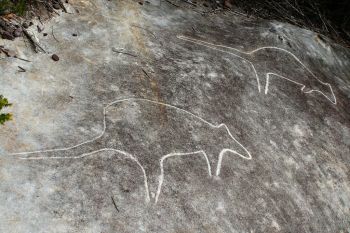 |
|
Engraved
wallabies, Elvina Bay Track Aboriginal rock
engraving site
|
Looking at northern Sydney more specifically, this area has, according to Paul, one of the largest concentrations of cultural sites in the world, with over 2,000 recorded instances of rock art and painting. Their preservation, it seems, is an accident of history. The Pittwater area would have offered Aboriginal people a plentiful food supply, but the land was of little interest to Europeans since, unlike western Sydney, it didn’t lend itself to agriculture. Thus we have a region of relatively dense Indigenous settlement, yet one comparatively undisturbed by European ingress.
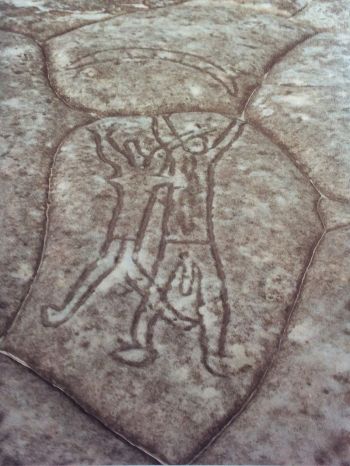 |
|
A
petroglyph of male and female dancers,
Ku-ring-gai
Chase National Park.
|
Paul described Aboriginal society as non-hierarchical. ‘Responsibilities were shared, everyone had a role to play.' And that’s why the decimation of the population after 1788 was so catastrophic, since it caused gaps in Aboriginal society which were not easily filled.
Obviously a two-hour talk could barely scratch the surface of a topic such as Indigenous culture. Among the valuable things to come out of the event were Paul’s suggestions as to further reading. The more accessible recommendations include:
- Jo McDonald, Dreamtime Superhighway – an Analysis of Sydney Basin Rock Art and Prehistoric Information Exchange (ANU 2008, 380 pages), available here. This explores how cultural places convey both sacred and practical information across a wide area.
- Val Attenbrow, Sydney’s Aboriginal Past: Investigating Archaeological and Historical Records (2nd Edition, April 2010), details available here. This lists hundreds of sites in northern Sydney, with carbon dating information.
- Paul Irish, Hidden in Plain View: The Aboriginal People of Coastal Sydney (2017), details available here.
For details of the second history talk, see below.
The
Two Catherines: Perspectives on Island History
Scotland Island Community Hall
Saturday 20 November, 2 - 4 pm
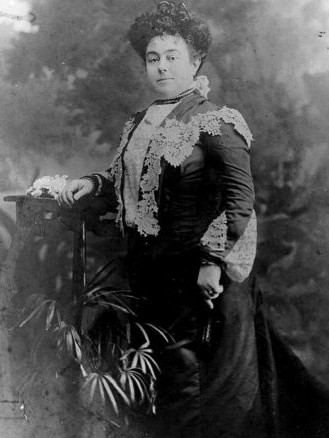 |
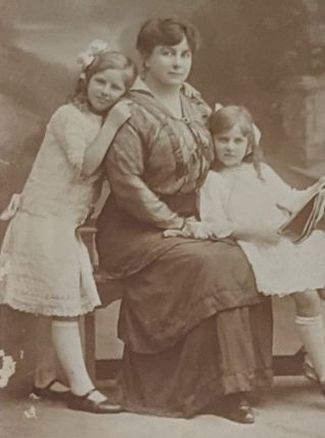 |
|
Catherine
Bouffier (1857 - 1940),
after
whom Scotland Island's Catherine Park is
named.
|
Catherine's daughter, Elvina, after whom Elvina Bay is named. Elvina's two children, Pat and Hilda, gave their names to a reserve on Scotland Island. |
Saturday will see the second of two talks relating to the history of Pittwater.
This talk will look at the arrival of European settlers in the area, and their relations with Indigenous locals. Speakers include local historian Paul Griffiths and islander Craig Burton. It will include a Welcome to Country from Neil Evers, Chair of the Aboriginal Support Group, Manly Warringah Pittwater.
The event will focus on Catherine Bouffier. Descended from German migrants, Catherine married into the Bouffier family, pioneers in the wine industry in the Hunter Valley. Catherine kept her husband's business afloat after his death and Bouffier Brothers became a major Australian wine label around the time of federation.
Catherine was the mother of Florence and Elvina. Florence went on to marry Herbert Fitzpatrick, who developed Scotland Island and Elvina Bay for housing in the 1920s. Florence gave her name to Florence Terrace, while Elvina Bay is named after her sister.
A video on Herbert and Florence Fitzpatrick, as well as Catherine Bouffier, can be found here.
Afternoon tea will be served.
REGISTRATION
In order to be COVID-compliant, registration is essential. Participants must be fully vaccinated (unless exempt). Please bring a mask and a phone to check in.
To register, click here.
Table Tennis
Scotland Island Community Hall
Most Saturdays, 3 - 5 pm
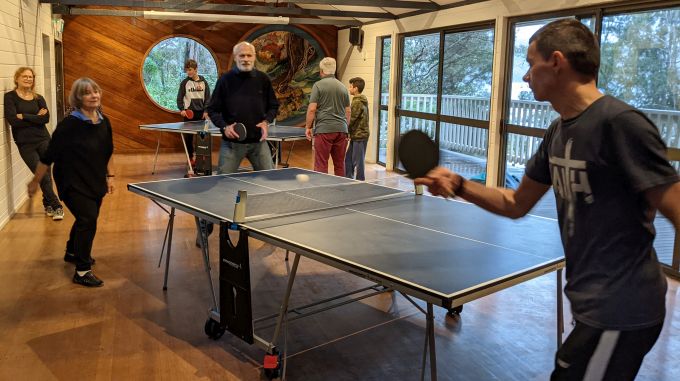
With COVID restrictions
lifting, table tennis sessions have recommenced. Groups
meet most Saturdays.
Anyone over 12 is welcome,
provided that those over 16 are fully vaccinated (unless
exempt). Please bring a mask to wear indoors, although
it may be removed during physical exercise.
If you would like to join a
WhatsApp group for up-to-date information on sessions,
please email editor@scotlandisland.org.au.

Bird
Prints Art Workshop
Scotland Island Recreation Centre
Saturday 20 November, 10 - 12 noon
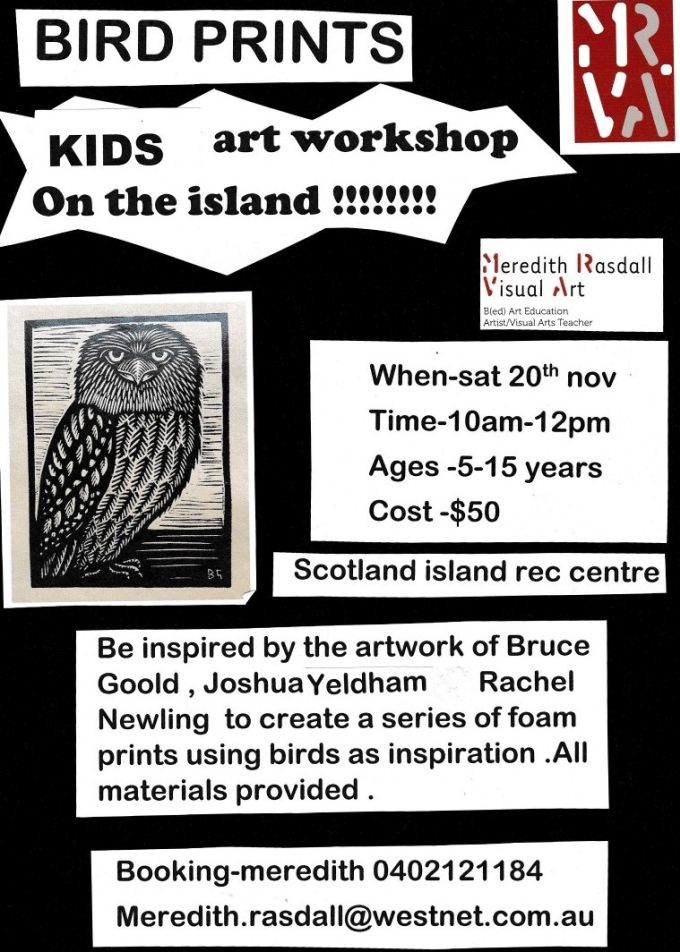
Scotland
Island Fire Brigade: Training
Sunday 21 November, 9 - 12 noon
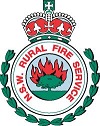
Please register your attendance using the SIRFB website.
COVID protocols will be observed, including the wearing of masks indoors.

International
Folk Dancing
Scotland Island Community Hall
Saturday 27 November, 7 - 9 pm
Christmas party: please bring a plate and a bottle to share
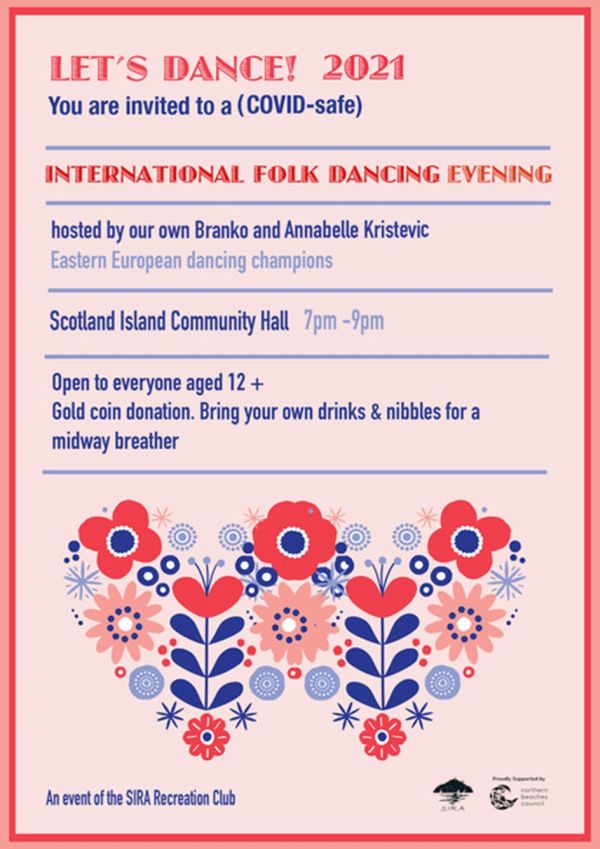
NB:COVID protocols apply:
- everyone aged 16 or older must be fully vaccinated (unless exempt)
- Please bring a mask.

Scotland Island Café
Sunday 28 November, 10 - 12 noon

Kids and double
vaxxed adults are welcome!
The 28 November café will
include stalls selling goods made by islanders. Get in
early and do some Christmas shopping of hand-crafted
gifts!
Further makers' stalls
will also be at our 5 and 12 December island cafés.

Book
Launch: 'Water Access Only'
Scotland Island Recreation Centre, Sunday 5 December
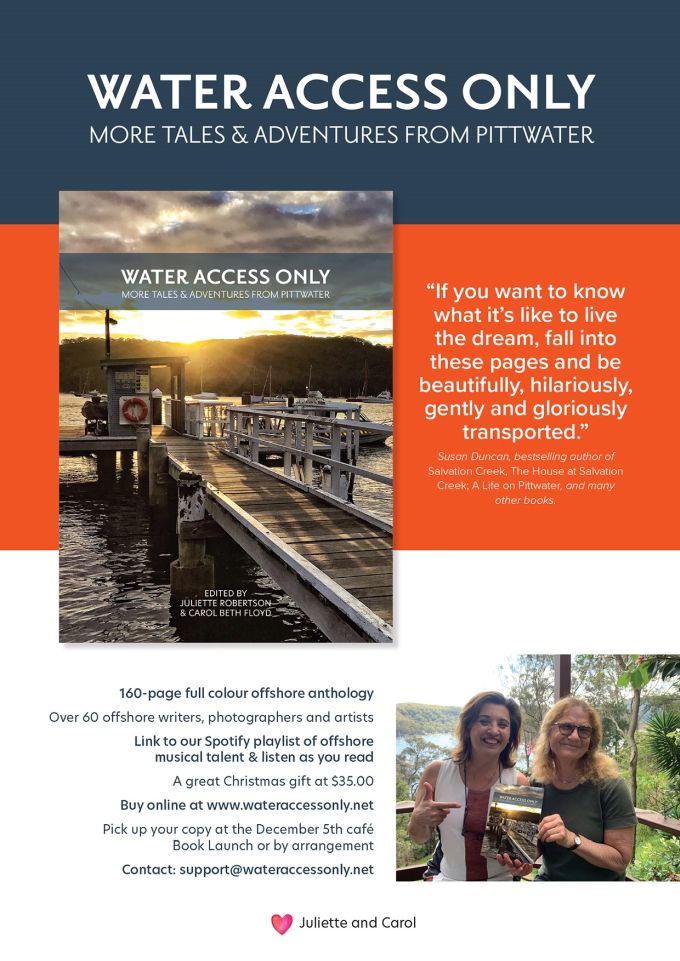
Young
Musicians' Concert
Scotland Island Community Hall
Sunday 5 December, 2- 4 pm

Family and friends are
invited to enjoy music provided by local young and
young-at-heart performers.
Come and watch your
neighbours, and the children of your neighbours, show
what they can do.
Please bring a plate
to share.
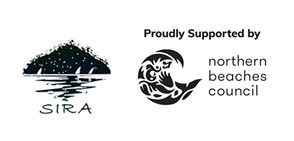

Missed out on a previous newsletter?
Past newsletters,
beginning May 2000, can be found and read at https://ymlp.com/archive_gesgjgm.php.
To Contribute
If you would like to contribute to this newsletter, please send an e-mail to the editor (editor@scotlandisland.org.au).Subscription Information
To subscribe or unsubscribe, go to: http://www.scotlandisland.org.au/signup.Follow the PON
 |
 |
 |
The Online Local Contacts Guide
Click HERE to load
Pittwater Offshore Photo Gallery
Updated
June 2021
Festival of Making,
April 2021
The
views
expressed in this newsletter are not necessarily the
views of the Scotland Island Residents Association
(SIRA), or the Western Pittwater Community
Association (WPCA)

